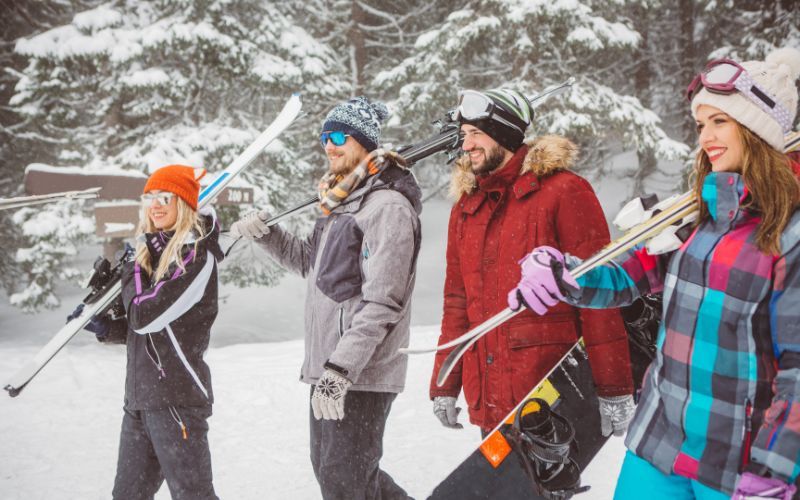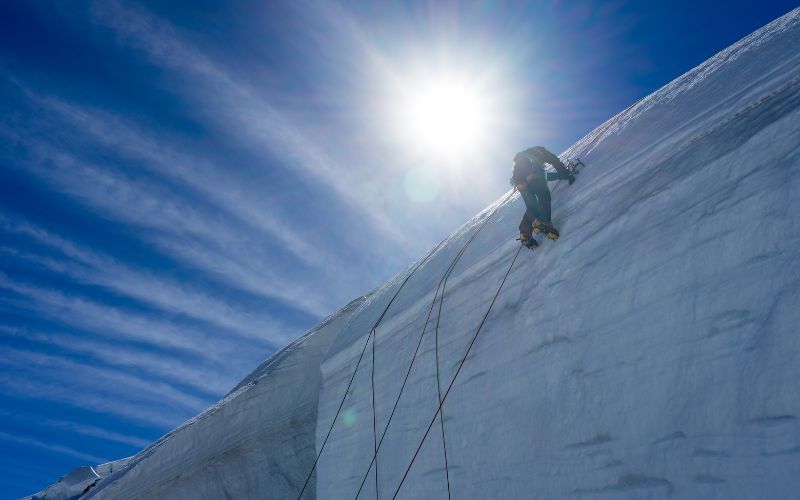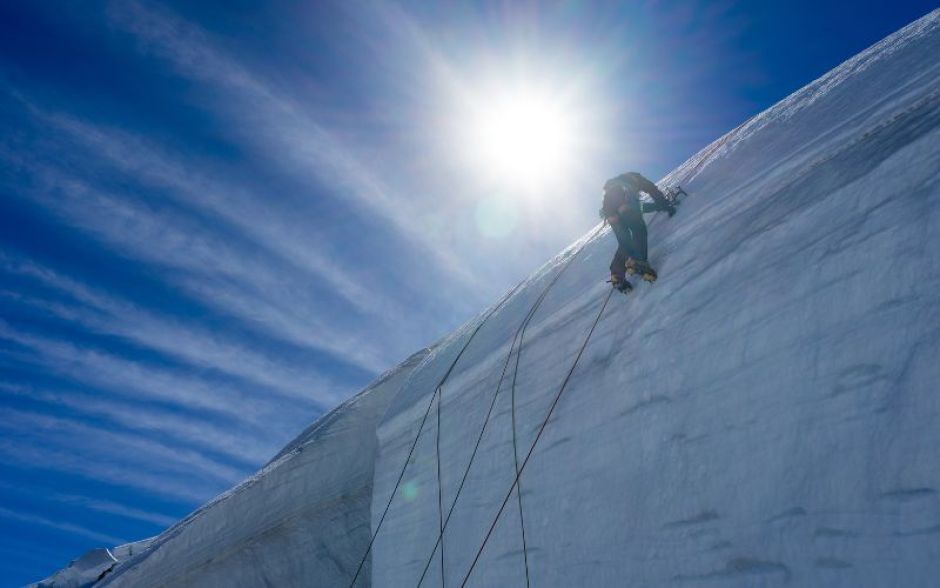
Ice Climbing Basics: Building Strength and Super Endurance in the Chill 2023
Ice Climbing Basics – When the temperatures plummet and frozen waterfalls glisten in the winter sun, a unique and exhilarating sport comes to life: ice climbing. Scaling frozen walls of ice is not only a thrilling adventure but also a test of strength, endurance, and mental resilience. If you’re intrigued by this cold-weather pursuit or are looking to hone your ice climbing skills, you’ve come to the right place. In this comprehensive guide, we’ll delve deep into the world of ice climbing, covering the basics, techniques, and training methods to help you conquer icy heights with confidence.
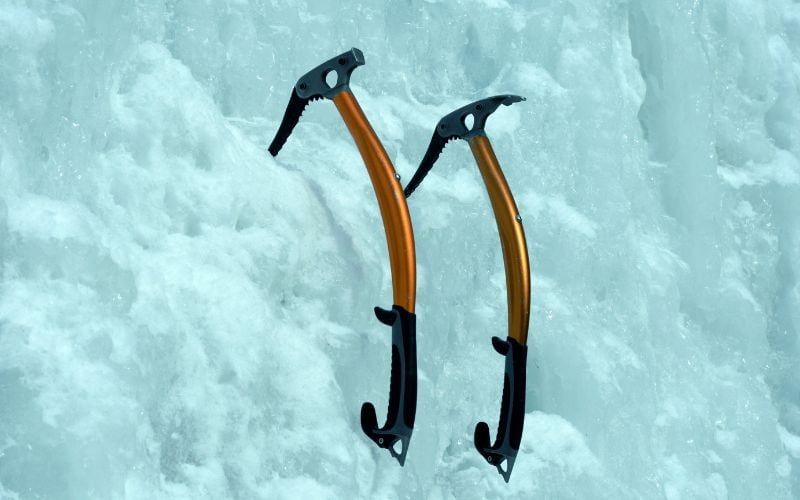
The Call of the Frozen Wilds: Embracing Ice Climbing – Ice Climbing Basics
Table of Contents – Ice Climbing Basics
Ice climbing basics is an outdoor adventure that takes you to some of the most stunning and remote winter landscapes. It’s a thrilling blend of physical prowess and mental fortitude, requiring strength, endurance, and a deep connection with nature’s frozen wonders.
As you ascend frozen waterfalls and ice-covered rock faces, you’ll feel the rush of adrenaline and the satisfaction of conquering nature’s icy challenges. However, before you embark on this exhilarating journey, it’s essential to grasp the fundamental principles and techniques that underpin ice climbing basics. This guide will serve as your roadmap to mastering the ice climbing basics of this awe-inspiring sport.
Ice Climbing Essentials – Ice Climbing Basics
Understanding the Gear: Your Tools for the Climb – Ice Climbing Basics
To embark on your ice climbing journey, it’s crucial to acquaint yourself with the specialized gear designed to tackle the unique challenges posed by frozen terrain. Understanding your equipment not only ensures your safety but also enhances your overall climbing experience. Let’s delve deeper into the essential gear you’ll need to get started and how each component plays a vital role in your ice climbing adventure:

Ice Axes and Crampons: Your Trusty Companions – Ice Climbing Basics
Ice axes and crampons are the heart and soul of ice climbing, providing you with the means to ascend vertical ice walls and navigate challenging icy terrain. Here’s what you need to know about these essential tools:
Ice Axes: These versatile tools are your primary means of gaining purchase on the ice. They come in various shapes and sizes, but all share common features such as a pick and an adze or hammer. The pick is used to penetrate the ice, while the adze or hammer can be employed for tasks like clearing ice or creating placements for protection.
- Leash or Leashless: Ice axes may have leashes or be leashless. Leashes attach the axe to your wrist, preventing accidental drops. Leashless axes rely on a secure grip without leashes, offering greater freedom of movement but requiring a firm grip.
Crampons: Crampons are traction devices that attach to your boots, providing secure footing on icy surfaces. They consist of metal frames with multiple points, including front points (located at the toe) and secondary points (distributed along the sides and heel). Here’s what to consider when choosing crampons:
- Type of Crampons: Different crampons are designed for specific activities. Automatic crampons are suitable for technical ice climbing, while semi-automatic and strap-on models work well for less technical terrain.
- Front Point Configuration: Crampons can have mono-point (single front point) or dual-point (double front point) configurations. Mono-points offer precision on small ice features, while dual-points provide stability on broader ice surfaces.
Helmet: Your Head’s Best Friend – Ice Climbing Basics
Safety should always be a top priority when ice climbing, and that includes protecting your head. A climbing helmet is a must-have piece of gear, serving as your defense against falling ice, equipment, and potential rockfall. Look for a helmet that meets industry safety standards and offers a snug and comfortable fit. Remember, a properly fitted helmet can make the difference between a minor incident and a severe injury.

Harness and Belay Device: Safety in Suspension – Ice Climbing Basics
Your harness and belay device are essential components of your climbing safety system, ensuring you remain securely attached to the rope at all times. Here’s what to know about these critical pieces of gear:
Harness: A climbing harness wraps around your waist and legs, connecting you to the rope. Look for a harness that offers adjustability and padding for comfort during long climbs. Ensure it has gear loops to accommodate carabiners, ice screws, and other essential equipment.
Belay Device: A belay device allows you to control the rope during climbs, belaying your partner, and descending. There are various types of belay devices, including tube-style devices and assisted-braking devices. Familiarize yourself with the specific usage instructions for your chosen device and practice safe belaying techniques.
Ice Screws and Anchors: Secure Protection – Ice Climbing Basics
Ice screws and anchors are vital for creating anchor points and securing your rope to the ice. Proper placement and reliable anchors are critical for safety during climbs. Key considerations include:
- Types of Ice Screws: Ice screws come in different lengths, ranging from short (for thinner ice) to long (for thicker ice). Practice screw placement techniques to ensure they are firmly anchored.
- Anchor Building: Learn how to create ice anchors using ice screws, pickets, or other available materials. Building secure anchors is essential when setting up belay stations or rappelling.
Layered Clothing: Battling the Elements – Ice Climbing Basics
Staying warm and dry in cold, wet conditions is essential for a successful ice climbing experience. Layered clothing is the key to regulating your body temperature and remaining comfortable throughout your climb. Here’s a breakdown of the layers you should consider:
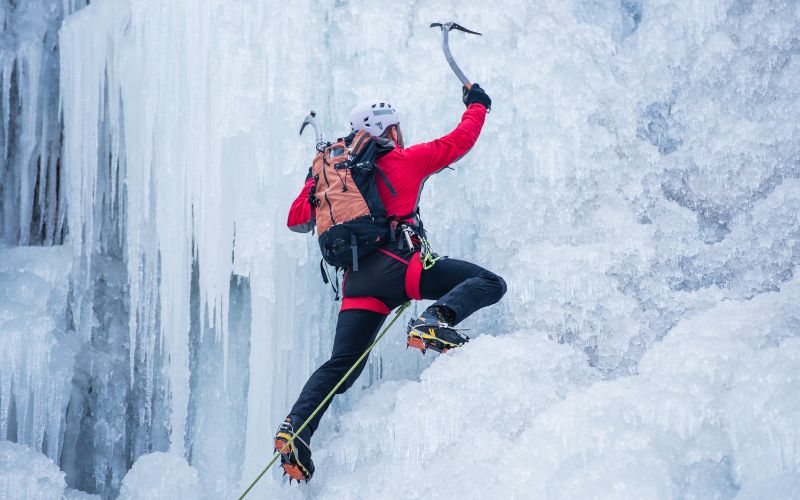
- Base Layer: A moisture-wicking base layer is the foundation of your clothing system. It wicks sweat away from your skin, keeping you dry and preventing moisture-induced cooling.
- Insulating Layer: An insulating layer provides warmth by trapping heat close to your body. Common materials include fleece, down, or synthetic insulation. The thickness of this layer can be adjusted based on the temperature.
- Outer Layer: The outer layer serves as your shield against wind, snow, and moisture. It should be waterproof, windproof, and breathable to protect you from the elements while allowing excess heat and moisture to escape.
- Accessories: Don’t forget essential accessories such as gloves, mittens, hats, and neck gaiters. Properly insulating your extremities is crucial for maintaining warmth and dexterity.
Understanding your gear and selecting the right equipment for your ice climbing adventure is a foundational step toward a successful and enjoyable climb. Invest time in familiarizing yourself with each piece of gear, practice using it in controlled settings, and ensure everything is in excellent working condition before heading out into the challenging world of ice climbing.
Techniques for Ice Climbing: Mastering the Fundamentals – Ice Climbing Basics
Ice climbing demands a unique set of skills and techniques that differ from traditional rock climbing. Developing proficiency in these fundamental techniques is essential for a safe and successful ice climbing experience. Let’s delve deeper into the key skills you need to master:
Ice Tool Placement: The Art of Precision – Ice Climbing Basics
Proper placement of your ice tools is at the core of successful ice climbing. It’s not just about brute force; it’s about precision and efficiency. Here are some essential aspects to consider:

- Swing Technique: Mastering the swing of your ice tools is crucial. It should be controlled and precise, allowing you to accurately place the pick into the ice. Avoid wild swings, as they can cause unnecessary chipping and fatigue.
- Angle of Placement: Pay attention to the angle at which you insert your ice tool into the ice. A slightly downward angle, with the pick facing slightly out from the ice, often provides the most secure placement. Experiment with angles to find what works best for each situation.
- Setting the Pick: Ensure that the pick is set firmly in the ice before transferring your weight to it. A loose pick can result in a dangerous slip.
- Hooking: In addition to swinging your tools, you’ll often need to hook them onto features in the ice. Practice hooking techniques, both with the pick and the adze or hammer, to gain confidence in your ability to use these features effectively.
Footwork: Navigating the Icy Terrain – Ice Climbing Basics
Crampon technique is a critical aspect of ice climbing, as it provides stability, precision, and control. Consider the following elements of footwork:
- Front Pointing: Front pointing is the primary technique for ascending ice. It involves using the front points of your crampons to gain purchase on the ice. Focus on precision and proper positioning of your feet.
- Kicking Steps: When climbing less steep ice or snow, practice the technique of kicking steps. This involves using your boots to create secure footholds for both you and your partner.
- Using Secondary Points: In certain situations, you may need to use the secondary points (located along the sides and heel of your crampons) for stability. Learn to shift your weight and engage these points as needed.
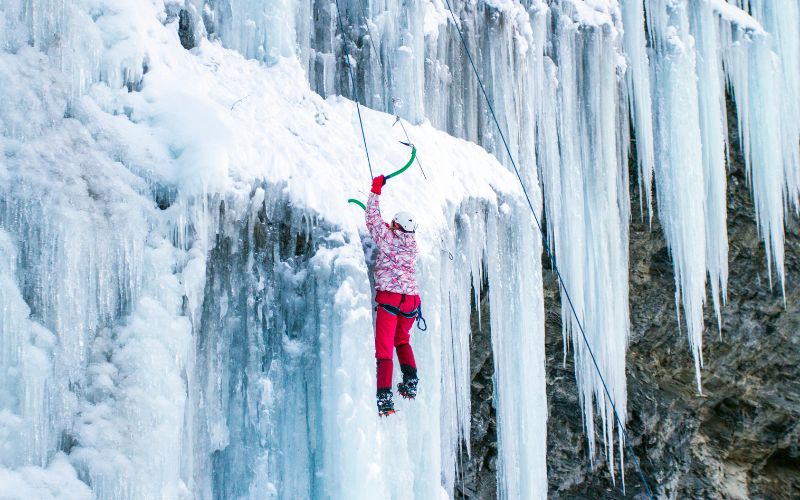
Balance and Body Positioning: Achieving Harmony – Ice Climbing Basics
Ice climbing requires a delicate balance between power and finesse. Your body position plays a significant role in maintaining stability and conserving energy:
- Weight Distribution: Be mindful of how you distribute your weight on the ice. Center your weight over your feet and crampons to minimize the risk of slipping or losing balance.
- Lean and Reach: As you ascend, you’ll often need to lean into the ice and reach for holds. Pay attention to your body’s positioning and use your hips and legs to create balance and control.
- Stance Changes: Adapt your stance and body position to the angle and features of the ice. Learning to switch between stances, such as front-pointing and flat-footed stances, is crucial for efficient climbing.
- Relaxation: Maintain a relaxed posture and grip on your ice tools. Tension and over-gripping can lead to fatigue and reduced precision.
Route Reading: Navigating the Ice – Ice Climbing Basics
Ice climbing routes can vary significantly in difficulty and terrain. Developing the ability to read the ice and plan your ascent accordingly is essential:
- Evaluating Ice Quality: Assess the quality and stability of the ice before committing to a route. Look for features such as fractures, air pockets, or discolored ice, which can indicate potential weaknesses.
- Planning Rest Points: Identify suitable rest points and stances along the route where you can pause to catch your breath and reevaluate your progress.
- Choosing Efficient Lines: Select the most efficient path up the ice, considering factors like features, thickness, and potential hazards.
- Route Protection: Understand the placement of ice screws and anchors along the route. Ensure they are secure and spaced at appropriate intervals for your safety.
Mastering these fundamental ice climbing techniques takes time and practice. Consider seeking guidance from experienced climbers or enrolling in ice climbing courses to receive hands-on instruction and build your confidence. As you develop proficiency in these skills, you’ll be well-prepared to tackle the challenges and rewards of ice climbing safely and with skill.
Building Strength and Endurance
Strength Training for Ice Climbing: Preparing Your Body – Ice Climbing Basics
Ice climbing places unique demands on your physical strength, particularly in your upper body, core, and grip. To excel in this exhilarating sport and tackle challenging ascents with confidence, incorporating targeted strength training exercises into your fitness routine is essential. Here, we’ll explore specific exercises and techniques to help you build the strength necessary for ice climbing success:

Pull-Ups: Building Upper Body Power – Ice Climbing Basics
Pull-ups are a fundamental exercise for strengthening your upper body, including your back, arms, and shoulders. Here’s how to incorporate pull-ups into your strength training regimen:
- Wide Grip Pull-Ups: These target your latissimus dorsi (lats) and shoulders. Perform pull-ups with your hands positioned wider than shoulder-width apart.
- Close Grip Pull-Ups: To engage your biceps and emphasize your forearm and grip strength, use a close grip with your hands positioned shoulder-width apart or closer.
- Assisted Pull-Ups: If you’re new to pull-ups or working on building strength, use an assisted pull-up machine or resistance bands to gradually increase your ability.
Core Exercises: Stability and Balance – Ice Climbing Basics
A strong core is vital for maintaining stability and balance on the ice. Incorporate these core-strengthening exercises into your routine:
- Planks: Standard planks, side planks, and forearm planks are excellent for building overall core strength. Focus on maintaining a straight line from head to heels during the plank.
- Russian Twists: Sit on the ground with your knees bent, lean back slightly, and lift your feet off the ground. Hold a weight or medicine ball and twist your torso to each side, engaging your oblique muscles.
- Leg Raises: Lie on your back and lift your legs straight up, engaging your lower abdominal muscles. Lower your legs back down without letting them touch the ground to work your core.
Hangboard Training: Strengthening Finger and Forearm Muscles – Ice Climbing Basics
Hangboard training is specific to ice climbing and is an excellent way to develop finger and forearm strength, which is crucial for gripping ice tools effectively. Here’s how to incorporate hangboard training into your routine:
- Finger Holds: Hang from various types of finger holds on the hangboard, such as crimps, pockets, and jugs. Gradually increase the duration of your hangs as your strength improves.
- Progressive Loading: Use a pulley system or weights to progressively increase the resistance on the hangboard, challenging your finger and forearm strength further.
- Fingerboarding Protocols: Follow established fingerboarding protocols and routines designed for ice climbing-specific training. These often involve different grip positions and durations.

Weighted Carries: Simulating the Climb – Ice Climbing Basics
Weighted carries mimic the demands of carrying gear and equipment while climbing, helping you build functional strength. Consider the following variations:
- Farmer’s Walks: Hold a weight in each hand, such as kettlebells or dumbbells, and walk a set distance. Farmer’s walks target your grip, traps, and shoulders.
- Overhead Carries: Hold a weight overhead with one hand and walk. This exercise challenges your shoulder stability and core strength.
- Zercher Carries: Hold a weight in the crook of your elbows (forearms resting on the weight) and walk. Zercher carries engage your upper body and core.
Remember to start with appropriate weights and gradually increase the load as you become more comfortable with the exercises. Maintain proper form and technique to prevent injury.
Incorporate these strength training exercises into your routine at least two to three times a week, focusing on progressive overload to continue building strength. As your upper body, core, and grip strength improve, you’ll be better equipped to handle the challenges of ice climbing, scale frozen walls with confidence, and experience the thrill of ascending to new heights.
Endurance Training: Building Stamina for Long Climbs – Ice Climbing Basics
Endurance is vital for sustaining your energy during extended climbs. Here’s how to enhance your endurance for ice climbing:
- Cardiovascular Training: Incorporate aerobic exercises like running, cycling, or swimming into your routine to boost your cardiovascular fitness.
- Interval Training: High-intensity interval training (HIIT) can mimic the intensity of ice climbing and improve your ability to recover quickly during climbs.
- Long Climbing Sessions: Gradually increase the duration of your climbing sessions to build endurance gradually. Focus on maintaining a consistent pace and rhythm.
Safety and Risk Management – Ice Climbing Basics
Safety Protocols: Protecting Yourself and Your Team – Ice Climbing Basics
Safety is paramount in ice climbing. Implement these safety protocols to minimize risks:
- Avalanche Awareness: If climbing in avalanche-prone areas, obtain training in avalanche safety and carry the necessary equipment, including a beacon, shovel, and probe.
- Weather Monitoring: Stay informed about weather conditions, especially temperature fluctuations that can affect ice stability.
- Communication: Maintain clear communication with your climbing partner. Establish signals and check-in procedures.
- Rappelling: Practice rappelling techniques and ensure you have a secure anchor system for descents.
- First Aid Training: Equip yourself with basic first aid skills and carry a well-stocked first aid kit.
Conclusion – Ice Climbing Basics
Mastering the Chill: Your Journey into Ice Climbing
As you embark on your ice climbing adventure, remember that mastery of this thrilling sport takes time, dedication, and a commitment to learning. Ice climbing basics are just the beginning of your journey. With the right gear, techniques, strength, and endurance, you’ll conquer icy heights and unlock the beauty of frozen landscapes. Approach each climb with respect for nature, safety in mind, and the determination to embrace the exhilaration of ice climbing. Welcome to the world of frozen challenges and awe-inspiring rewards.
You might also like:
Popular Stories
Newsletter
About me
Meet Dennis, an enthusiast of the great outdoors. For the past 15 years, he’s maintained a daily routine that includes running, hiking, and hitting the gym, embodying a commitment to an active and healthy lifestyle.
Dennis is a true advocate for the joy and rejuvenation that outdoor living can bring.

